The Executive Branch
ROLLOVER ON IMAGE
The Executive Branch
The Executive Branch of government is outlined in Article II of the Constitution. It is the largest branch of government and is responsible for enforcing or executing the laws. It includes the President of the United States, the Vice President, the fifteen executive departments and their heads which constitute the President's cabinet, the Executive Office of the President and many regulatory commissions and independent agencies.
Watch The Almost Painless Review: The Executive Branch (1:12) to preview what you will learn in this lesson.
The Almost Painless Review: The Executive Branch (1:12)
Click here to view the instructions for logging in to Discovery Education Streaming videos.
The President
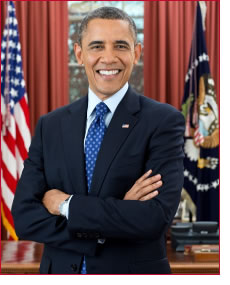
Barack Obama, the forty-fourth president of the United States of America.
The President serves as head of the executive branch of government. The executive branch is vast and has many parts that all ultimately answer to the President. The President is widely considered to be the most powerful person in the world. In this lesson, you will explore what the Constitution says regarding the qualifications, election, and roles for the office of the President.
Visit the official White House website to learn more about the Executive Branch.
Official Presidential Roles
The Article II of the Constitution assigns the following official roles to the President:.
- As Chief Executive, the President must execute or carry out the law and see that government programs are carried out.
- As Chief Administrator, the President manages or directs the government including the 15 executive departments and federal agencies.
- As Commander in Chief, the President leads the U.S. armed forces and can send troops into action or call them home.
- As Chief Legislator, or Chief Agenda Setter, the President presents a legislative agenda and suggested budget to Congress.
- As Chief Diplomat, or Foreign Policy Leader, the President directs the nation's foreign policy including negotiating treaties, directing ambassadors, and setting the agenda for diplomacy.
Symbolic Presidential Roles
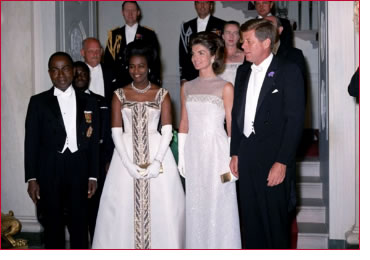
.jpg)
In the picture on the left, President John Kennedy and his wife Jaqueline, right, are shown at a dinner in honor of the President of the Ivory Coast in 1961. In the picture on the right, President Ronald Reagan and his wife Nancy, left, appear with Soviet leader Mikhail Gorbachev and his wife Raisa at a White House State Dinner in 1987.
Office of the President
The Framers of the Constitution decided the President should serve a four-year term with a chance for re-election. The Constitution did not set a limit of the number of terms a President could serve, but George Washington, who served as the nation's first President from 1789-97, set a precedent when he decided to leave the presidency after two terms.
All presidents after Washington followed his example until Franklin D. Roosevelt was elected to a third term in 1940 and a fourth in 1944. After Roosevelt's death in 1945, Congress decided to limit the number of presidential terms. The Twenty-second Amendment to the Constitution, ratified in 1951, limits presidential terms to two for any one person, or to one elected term if the person has completed more than two years of another president's term.
Office of the President
The Constitution was also left room for questions about the succession of the presidency. Article II states that the Vice President shall assume the duties if the President dies, is removed from office, or resigns. It was not until the Twenty-fifth Amendment was ratified in 1967 that the full line of succession and procedures for temporary illness of the President was clearly established.
Visit Ben's Guide to learn more about the order of succession.
Benefits of the Office of President
ROLLOVER ON IMAGE
Benefits of the Office of President
ROLLOVER ON IMAGE
Qualifications for President
Article II Section 1 of the Constitution sets the formal qualifications for President. The President must be a natural-born citizen of the United States, be at least 35 years old, and have lived in the United States for 14 years.
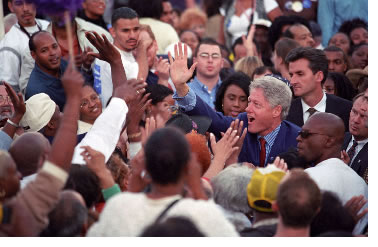
Photograph of President Clinton Greeting People in a Large Crowd in Los Angeles, California, 11 02 2000 -Public Domain
Qualifications for President
In addition to formal qualifications, the President must win the support and votes of the people. Therefore, presidential candidates must display positive personal qualities that include good leadership, communication skills, charisma, dignity, confidence, poise, and overall likability.
Watch Electing the President (2:39) to learn more about the qualifications for the office of president.
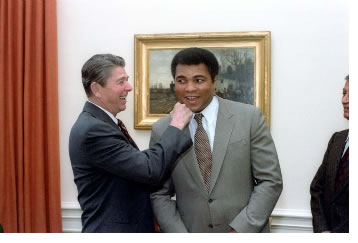
President Reagan "punching" Muhammad Ali .1/24/83
Electing the President
Article II, Section 1 of the Constitution outlines the process of electing a President. Many Americans are surprised to learn that when they go to the polls every four years to make their choice for President, their vote does not directly elect the President. Our votes actually elect people, called electors, who pledge to support the candidate we choose. The electors represent the voters of each state and make-up the Electoral College which is the formal body created by the Constitution that elects the President.
So, it is the Electoral College that determines who will be President, not the popular vote of the people. The Founding Fathers worried that the people might make an unwise decision in a direct election. The process of states selecting electors who in turn vote for the people was an effort to compromise and preserve the power of democracy.
The Electoral College
The Electoral College was also an attempt by the Founding Fathers to prevent one state or a region of the country from dominating the presidency. The idea was to create a balance between the large and small states. Therefore, the Electoral College has the same number of electors from each state as there are Senators and Representatives in the Congress with a total of 538 electors counting the three from the District of Columbia (Washington, D.C.). A presidential candidate must capture 270 electoral votes to win.
Watch Electoral College (3:58) to learn more about the Electoral College.
2012 Presidential Election Electoral Map
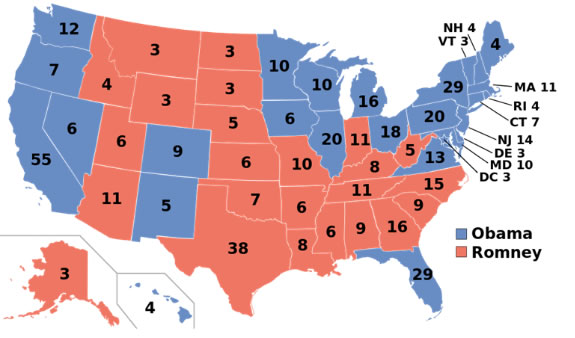
The map above illustrates the Electoral College results of the 2012 Presidential Election. The blue states were won by the Democratic candidate, President Barack Obama, who captured 332 electoral votes to win the election. The red states were won by the Republican party's candidate, Massachusetts governor Mitt Romney, who won 206 electoral votes.
Issues with the Electoral College
There have been some issues with the Electoral College. Because some more populous states like California and Texas have more electoral votes, presidential candidates tend to spend more time campaigning in those states. Summer is a critical time for candidates to campaign across the nation in preparation for the primaries the following spring. In the political cartoon on the right, Ohio Senator Robert Taft examines an electoral map to help plan his "summer schedule" with the hopes of winning the presidency.
ROLLOVER ON IMAGE
Issues with the Electoral College
Another major issue that can occur with the Electoral College involves the fact that it is possible for a candidate to lose the popular vote but receive the most electoral votes to win the presidency. This has happened four times in our history with the most recent occurring in the 2000 Presidential election (see the electoral map on the next slide).
Watch The 2000 Presidential Election (1:40) to learn more about how the Electoral College does not always reflect the popular vote.
The 2000 Presidential Election (1:40)
2008 Presidential Election Electoral Map
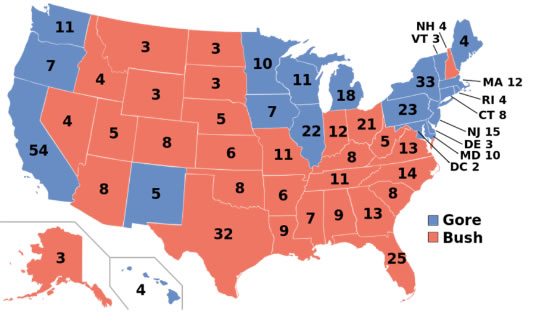
The map above illustrates the Electoral College results of the 2008 Presidential Election. The red states were won by the Republican party's candidate, George W. Bush. The blue states were won by his Democratic challenger, Al Gore. Bush won 271 electoral votes to win the election while Gore won 266. However, Gore won the popular vote with 50,999,897 to Bush’s 50,456,002.
Summary and Review
Many Americans express a desire to do away with the Electoral College and replace it with a direct popular vote. Despite its problems, the Electoral College has endured. The graphic to the right demonstrates how the winner of the popular vote can still lose in a hypothetical Electoral College system.
Watch Becoming President (3:16) to review what you have learned about electing a President.
ROLLOVER ON IMAGE